The Mangalore-Bangalore route via Shiradi Ghat, NH75, previously NH48. We have driven up and down that road so many times over the last 20 years, that I even know which lane to be in for a smoother ride while driving over the irritating rumbler speed bumps (stay left on the Hassan bypass stretch, at all others stay right ;-)). So it is no surprise that we knew the existence of a fort just after Sakleshpur town (while driving from Bangalore towards Mangalore) but somehow never stopped to visit. Over time a worn-out direction board to mark the way to the fort was replaced by the Karnataka Tourism’s bright yellow board. The board has disappeared, but the fort hasn’t, but it will, given the present state of neglect. That would be sad because the fort is one of a kind that still exists.
I am talking about Tipu Sultan’s Manjarabad Fort.
Between his father Hyder Ali and himself they had conquered and ruled over a sizeable area covering the present day Indian states of Karnataka, Kerala, Tamil Nadu and Andhra Pradesh. Tipu had flourishing trade relations overseas. Movement of goods to seaports without them being subject to thievery and looting was a major concern. In most places that he conquered, he fortified the existing structures. So be it the fort in Nandi Hills, or Bangalore or at his birthplace Devanahalli, the fort takes the shape of the geography of the land or at best will be vaguely circular. Manjarabad is different.
It is a star shaped fort with 8 vertices. Tipu Sultan constructed the fort in the 1790s with tech know-how from his French friends who were aiding him in his battles against the British. Sebastien Le Prestre de Vauban who was a French Military Engineer is credited with coming up with the 8-point star shaped design for forts. Having bastions at the sharp corners where the two vertices meet eliminated the ‘dead zone’ that is typically created by a round or square shaped bastion. His theories on fortifications and warfare were in use much after he passed away.
Manjarabad fort was meant to keep an eye over the Coorg (Madikeri) to Mangalore route. Situated on a hill, it must have been the perfect lookout for enemies. Today, the awe-inspiring views are accompanied by the sound of the chugging train, the vroom of cars and other vehicles on the highway.
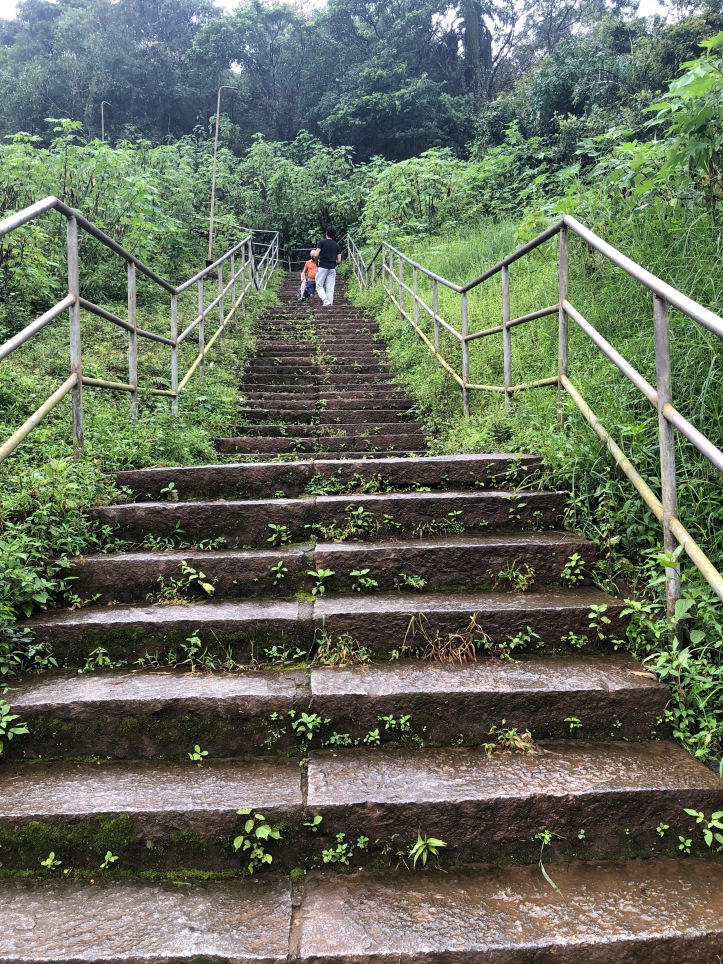

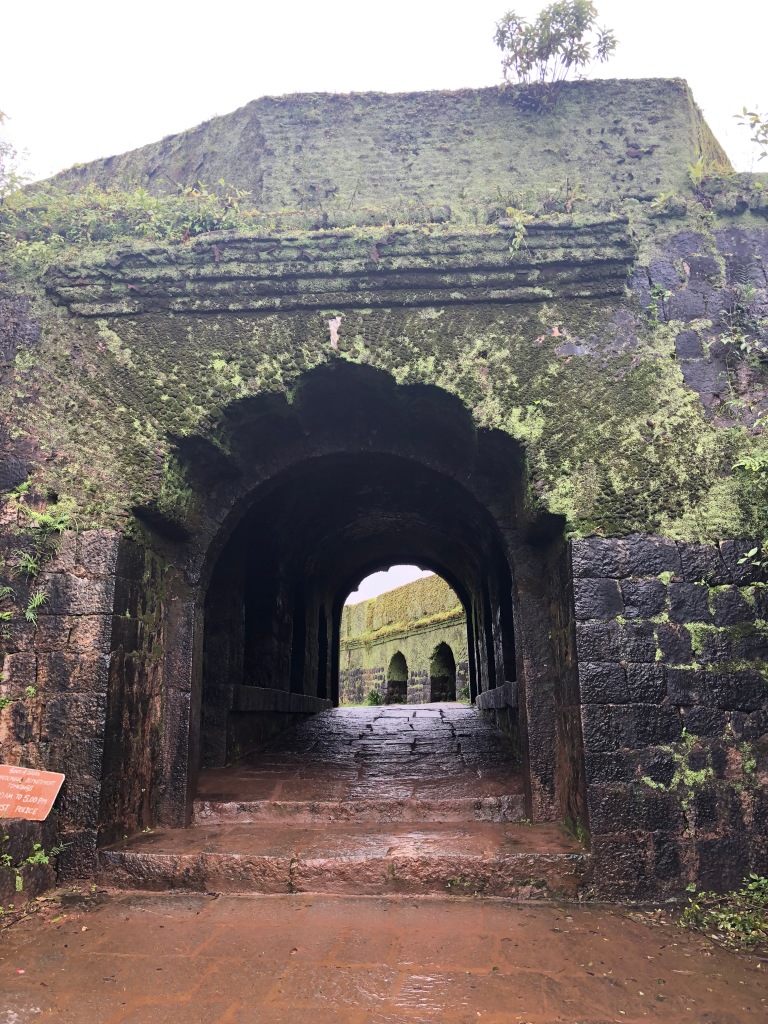
The fort walls are built using granite blocks and lime mortar, and the inner structure is made of bricks. Army quarters, storehouses and armoury are built into the fort wall. There is a deep well with steps leading down to it from four sides, The well is flanked on two sides by a pair of gunpowder storehouses that are built into the ground so as to remain cool through the summer months.
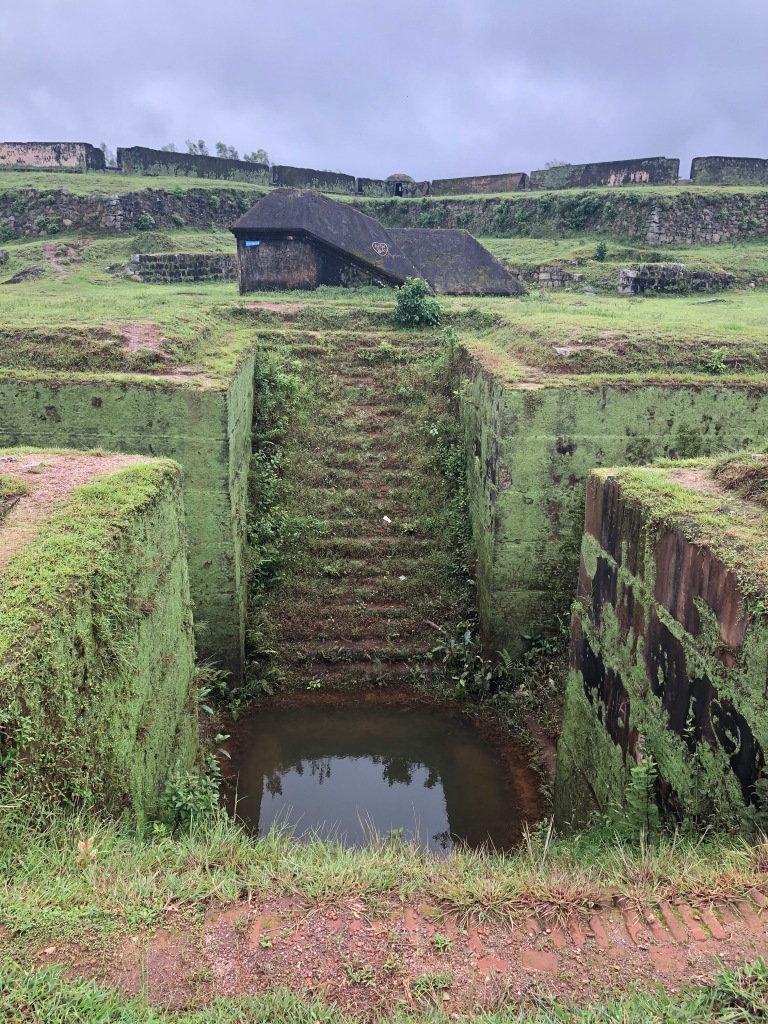
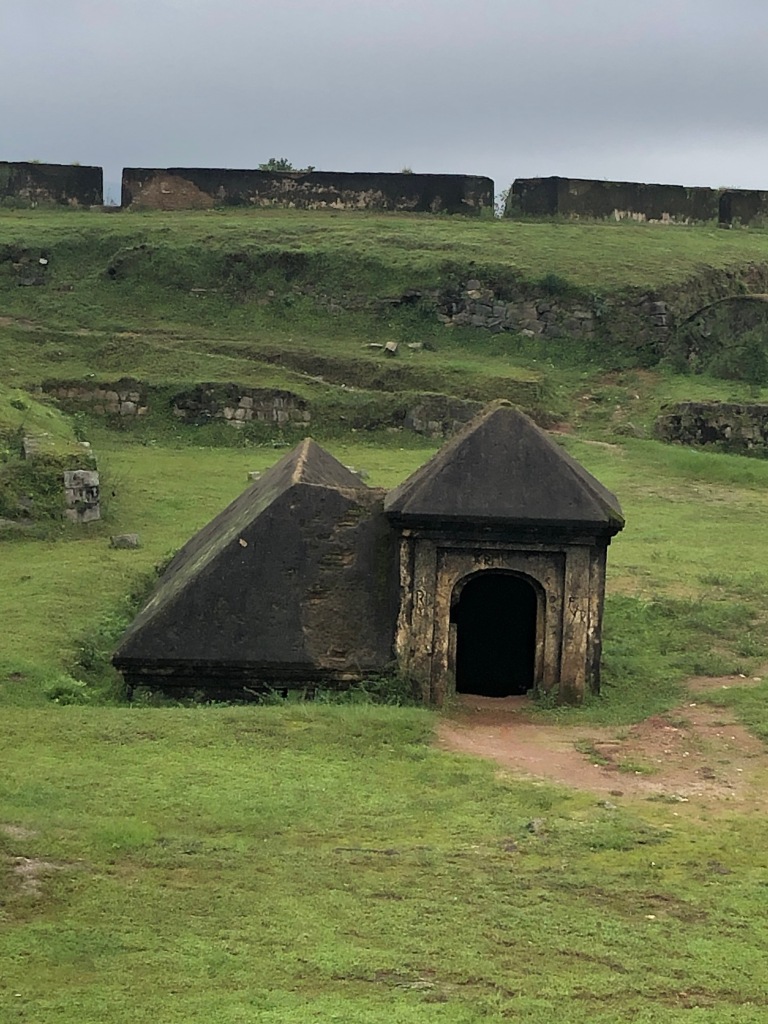
I tried to walk into the storehouse but it was dark and wet with standing water (it is rainy season now as you can tell from the pictures). Bastions can be seen at every pointy edge of the star. There is a deep ditch between the inner and outer walls of the fort. The inner star is at a higher elevation than the outer star. The outer walls also still exist but are hidden behind the overgrowth.

A bastion as seen from inside the fort 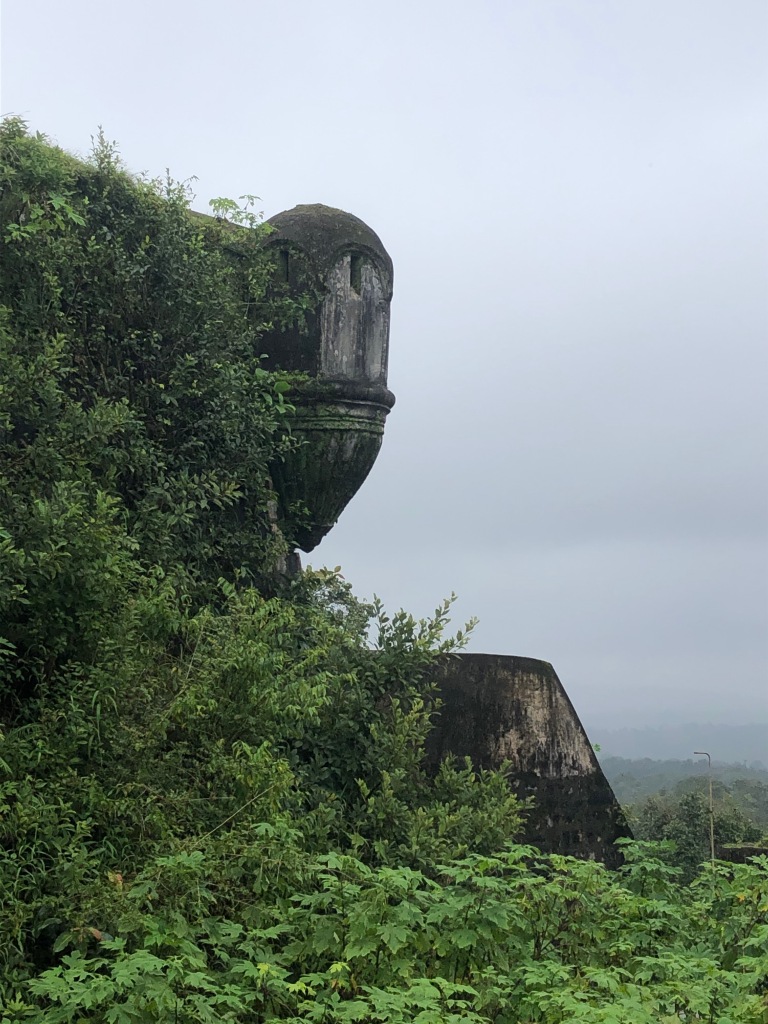
Bastion as seen from the outer periphery of the fort 
Entrance to the bastion 
Each bastion has four such thinly slit lookouts 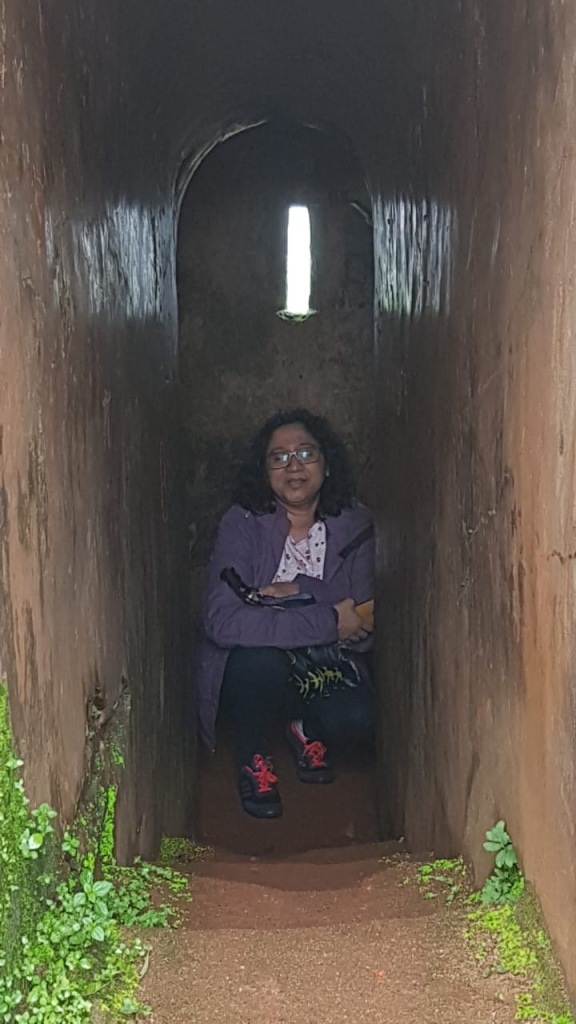
That’s me playing soldier soldier for a minute 🙂

It is rather difficult to visualise the shape of the fort while standing inside the fort. An image of the shape of the fort can be found on the ceiling at the fort entrance.


People must have tried to fly drones because there was a ‘warning’ to seek permission to use drones or pay a huge fine 🙂 Sadly there are no other information signages, except one according to which the visiting hours are 8am to 5pm.
If you find yourself in Sakleshpur do visit this fort which is 5km from the town centre. If you follow GoogleMaps and continue driving even after you read the ‘you have arrived at your destination’ message because you cannot see any signages to the fort, you would be making a mistake. If you can see ‘Hotel Picnic’ and ‘Sulabh Sauchalay’, then you have actually reached the correct spot. That spot is a wide curve with ample space off the road to park your vehicle safely. There is a narrow path that starts at the edge of the Hotel Picnic. Walk up till you see the flight of steps and walk some more to get to the fort entrance. Entry is free.

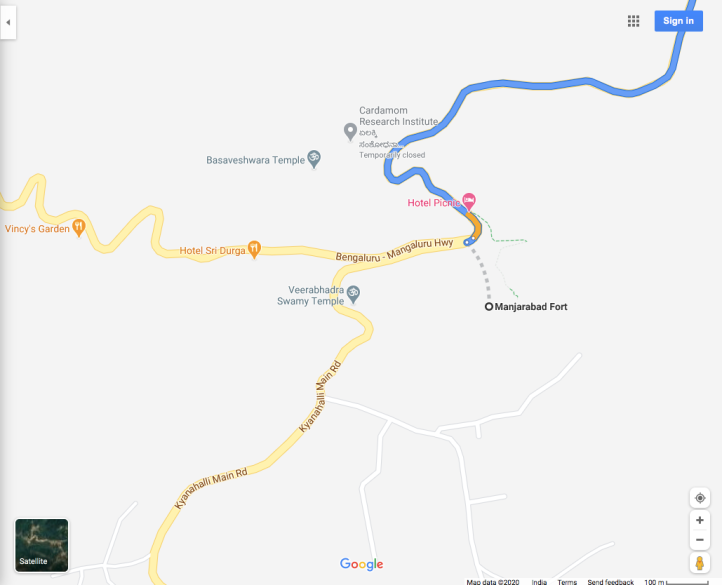
There used to be star shaped forts in India, for example Fort William in Kolkata and Fort Louis in Pondicherry. Neither exists making it all the more important that the Manjarabad Fort be preserved. If we let the overgrowth run wild any longer, the fort is as good as lost. It is always possible to walk around on the ramparts of a fort. Here, the path disappears quickly into the wilderness. I wonder if petty politics is the reason behind this neglect because in this region, depending on who you talk to, Tipu receives accolades or brickbats. Lessons can be learnt, people can be educated. A fort is a fort and it should not be made a scape goat.


Read your blog.Like you ,we have passed through this route umpteen times,but still has missed it. We will make it definitely one of these days.
With the rains,the photos are really fantastic and added to that is the history behind the Fort written by you.
It’s too good. I have become a follower of your blogs .I feel it’s better to read about a place by people who have been there rather than from any guides or books. There are somany places nearby which are not known or written and photos may be captivating.Chikkamma and I are really impressed.waiting your next blogs
LikeLiked by 2 people
Thank you Chikappa & Chikamma! I am so happy that you enjoyed reading this blog 🙂 Yes there are many places outside Bangalore, some are restored and well-kept, some may be quietly lost forever because we don’t even know of their existence!
LikeLike
Yes. Your blogs gives an insight about a place in detail.
As I said earlier,I like the photos being sent by Swathi,she briefs a lot about the place where photo was take.
We take photos and nothing else.
Sanjith also writes very well.Its really great to have such a talent.
We do visit places,but not a good writers 😊
LikeLiked by 1 person
Yes, I love swati’s photos. I started taking better pictures after I decided to blog 🙂
And thank you for following. You will be notified everytime I publish a new blog 🙂
LikeLike
As Chikappa mentioned, you have a talent for writing about history and the ambience of the place! Not to mention a very practical side too as you gave clear directions for people likely to get lost. In addition if you add details on where to stop for good food nearby, it will complete the loop for travelers.
I will keep adding to my list of places to visit when I come and this seems a good choice. Looking forward to more.
LikeLike
Thank you Sahana! Your suggestions have been noted 🙂
LikeLike
This is a neat place! Great Post!
LikeLike
Wonderful write up, K!! I have passed by the turnoff to the fort many times and everytime I have thought, next time! After reading your blog, I am convinced I have to visit this place next time.
I am looking forward to the next blog, keep me posted
LikeLiked by 1 person
Visit the immediate next time, not just any other next time 🙂
LikeLike
Such a gem of a fort! Surprisingly, I hadn’t heard of the fort before reading your post and such a pity because this is an important piece of history!
The sharply angled bastions are very uncommon but the theory behind the design is an interesting one. I wonder why more forts in the country didn’t adopt it?
And of course, a very informative writeup, as always 🙂
LikeLiked by 1 person
Thank you for your lovely words, Nomad. As I said in the blog, it took me so many years to finally see the fort despite it being on a regular route (ok I sound like a bus driver, but you get it dont you? :-))
What is also amazing is that it is built on a hill and that is no mean feat. As I was writing, it wondered too about why it did not become popular, or even why he choose to build this fort the way he did. Typically Tipu and his father conquered a principality from local chieftains/paleghars and fortified the place, building on existing conditions. Sadly, I do not have answers. FYI, several star shaped forts can be found in Europe, they still exist and can be visited.
LikeLike